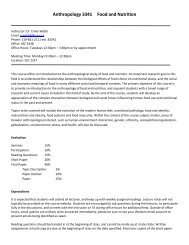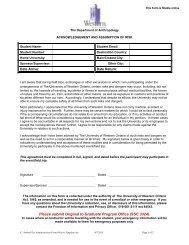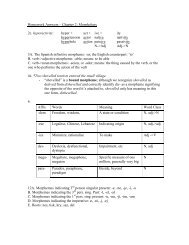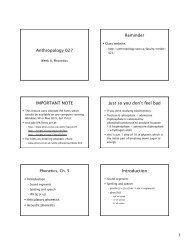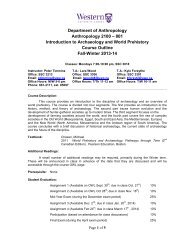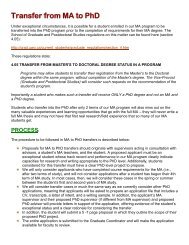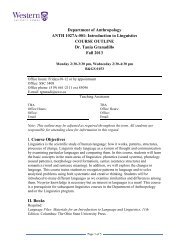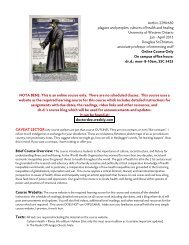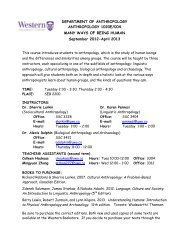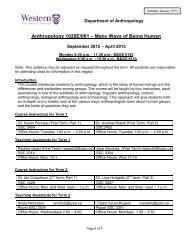Review Problems for Final Exam 1. The segments [r ... - Anthropology
Review Problems for Final Exam 1. The segments [r ... - Anthropology
Review Problems for Final Exam 1. The segments [r ... - Anthropology
Create successful ePaper yourself
Turn your PDF publications into a flip-book with our unique Google optimized e-Paper software.
<strong>Review</strong> <strong>Problems</strong> <strong>for</strong> <strong>Final</strong> <strong>Exam</strong><strong>1.</strong> <strong>The</strong> <strong>segments</strong> [r] and [l] are two surface variants of one phoneme in Luganda. Usingthe data below, choose an underlying representation <strong>for</strong> this phoneme and write aphonological rule with which the surface variant(s) can be derived. Consider analternative and show why it is not satisfactory.kolak do wulira hearlwana fight beera helpbuulira tell ɟɟukira rememberlja eat erjato canoeluula sit omuliro fireomugole bride effirimbi whistlelumonde sweet potato emmeeri shipeddwaliro hospital eraddu lightningoluganda Ganda language wawaabira accuseolulimi tongue lagira command2. <strong>The</strong> data below exhibit a phonological alternation in the <strong>for</strong>m of the noun stem <strong>for</strong>English. Formulate a phonological rule to account <strong>for</strong> it. (Ignore any vowelalternations.)signresigndesignparadigmdiaphragmphlegmsignatureresignationdesignationparadigmaticdiaphragmaticphlegmatic
3. Give the underlying representations <strong>for</strong> the noun stems in the following Turkish data.Write a phonological rule that accounts <strong>for</strong> the consonant alternations. Justify the ruleby suggesting an alternative and showing that it is inferior to your solution.noun stem possessed <strong>for</strong>m glossip ipi ropebit biti lousesebep sebebi reasonkanat kanadɯ wingʃeref ʃerefi honourkɯtʃ kɯtʃɯ rumppilot pilotu pilotdemet demeti bunchʃarap ʃarabɯ wineahmet ahmedi Ahmedpabutʃ pabudʒu slippergytʃ gydʒu powersepet sepeti basketsanat sanatɯ artkep kepi capkurt kurdu wormsatʃ satʃɯ hairrenk rengi colour
4. Two brothers, aged 4 and 5.5, were observed to speak a dialect of English deviatingin certain respects from the adult norm. This dialect was the only language spoken bythese children, and they used it communicating with each other, with adults, and withtheir playmates. <strong>The</strong>ir older brother, who understood this dialect, served as translator insituations in which they could not communicate effectively with adults. What two rulesprincipally distinguish the children's phonology from the phonology of the adultcommunity. Must they be stated in a particular order? If so, why?adult word children's word adult word children's wordpuppy pəʔij died dajʔkick kɪʔ took tejkəʔbaby bejʔij bit bɪtwalks wɑkt talked tɑkəʔwalked wɑkt daddy dæʔijran rənd bobby bɑʔijmen mænd tag tægpet pɛt paper pejʔərcan (3sg.) kænd takes tejktdid dɪʔ dogs dɑgddoes dəd toot tuwʔbeat bijt kake kejʔ




